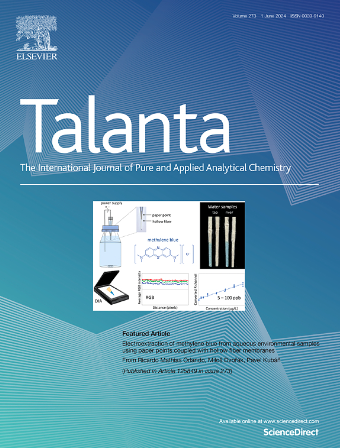聚乙烯醇膜上基于碳点聚集诱导发射增强的便携式精氨酸传感
IF 5.6
1区 化学
Q1 CHEMISTRY, ANALYTICAL
引用次数: 0
摘要
碳点(cd)具有优异的光学特性、光稳定性和可忽略的生物毒性,是一种极有希望应用于食品分析的纳米材料。以叶酸为前驱体,采用水热法合成了n掺杂CDs。NCDs在紫外光下表现出深蓝色荧光,量子产率为14.54%。在精氨酸(Arg)存在的情况下,NCDs的最大发射波长出现了10 nm的明显红移,并伴有从深蓝色到亮蓝色的荧光转变。Arg存在时,非传染性疾病的QY为16.71%。也就是说,在Arg的存在下,NCDs表现出聚集诱导的发射增强(AIEE)。在0 ~ 300 μM范围内,荧光增强与Arg浓度呈较强的线性相关,检测限为0.31 μM。此外,为了方便精氨酸检测,开发了一种采用聚乙烯醇膜辅助设计的便携式精氨酸传感器。该传感器对实际样品中精氨酸的检测结果令人满意。这些发现突出了具有AIEE特性的非传染性疾病的多种功能,为其在食品分析中的潜在应用铺平了道路。本文章由计算机程序翻译,如有差异,请以英文原文为准。

Portable arginine sensing on polyvinyl alcohol membrane based on aggregation-induced emission enhancement of carbon dots
Carbon dots (CDs) were highly promised nanomaterials for application in food analysis, owing to their exceptional optical properties, superior photostability, and negligible biological toxicity. N-doped CDs (NCDs) were synthesized via a straightforward hydrothermal method utilizing folic acid as only one precursor material. NCDs exhibited deep blue fluorescence under an ultraviolet lamp with a quantum yield (QY) of 14.54 %. In the presence of arginine (Arg), there was a noticeable redshift of 10 nm in the maximum emission wavelength of NCDs, accompanied by fluorescence transition from dark blue to bright blue. The QY of NCDs was 16.71 % in the presence of Arg. In other words, NCDs showed aggregation-induced emission enhancement (AIEE) in the presence of Arg. The fluorescence enhancement exhibited a strong linear correlation with Arg concentration within the range of 0–300 μM, and the limit of detection was 0.31 μM. Furthermore, to facilitate Arg detection, a portable Arg sensor was developed using a polyvinyl alcohol membrane-assisted design. The sensor demonstrated satisfactory performance in detecting Arg in real samples. These findings highlighted the versatile capabilities of NCDs with AIEE properties, paving the way for their potential applications in food analysis.
求助全文
通过发布文献求助,成功后即可免费获取论文全文。
去求助
来源期刊

Talanta
化学-分析化学
CiteScore
12.30
自引率
4.90%
发文量
861
审稿时长
29 days
期刊介绍:
Talanta provides a forum for the publication of original research papers, short communications, and critical reviews in all branches of pure and applied analytical chemistry. Papers are evaluated based on established guidelines, including the fundamental nature of the study, scientific novelty, substantial improvement or advantage over existing technology or methods, and demonstrated analytical applicability. Original research papers on fundamental studies, and on novel sensor and instrumentation developments, are encouraged. Novel or improved applications in areas such as clinical and biological chemistry, environmental analysis, geochemistry, materials science and engineering, and analytical platforms for omics development are welcome.
Analytical performance of methods should be determined, including interference and matrix effects, and methods should be validated by comparison with a standard method, or analysis of a certified reference material. Simple spiking recoveries may not be sufficient. The developed method should especially comprise information on selectivity, sensitivity, detection limits, accuracy, and reliability. However, applying official validation or robustness studies to a routine method or technique does not necessarily constitute novelty. Proper statistical treatment of the data should be provided. Relevant literature should be cited, including related publications by the authors, and authors should discuss how their proposed methodology compares with previously reported methods.
 求助内容:
求助内容: 应助结果提醒方式:
应助结果提醒方式:


